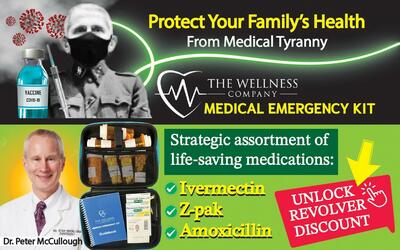Join the fight and contribute to our war chest
Ditch the ads for $5 per month or $49 per year
We all know there’s something strange going on with our food in the United States. All you have to do is take a trip abroad, and you will instantly notice a difference in how you feel. Most people report feeling less bloated, lighter, and more satiated. This has caused many people to wonder what on earth is going on with the food supply in America. We’re inundated with processed junk food, sugar, seed oils, corn, and other fillers and preservatives, and many people are starting to feel as if they’re being slowly poisoned. And things get even dicier when you compare the food scene in America to what’s going on in Europe.
Many of the chemical additives we use in food in the US are banned in other countries due to research indicating they’re potential cancer-causing agents.
From baguettes to focaccia, Europe is famous for its bread. But there’s one ingredient conspicuously missing: Potassium bromate. It’s a suspected carcinogen that’s banned for human consumption in Europe, China and India, but not in the United States.
In the U.S., the chemical compound is used by some food makers, usually in the form of fine crystals or powder, to strengthen dough. It is estimated to be present in more than 100 products.
“There is evidence that it may be toxic to human consumers, that it may even either initiate or promote the development of tumors,” professor Erik Millstone, an expert on food additives at England’s University of Sussex, told CBS News. He said European regulators take a much more cautious approach to food safety than their U.S. counterparts.
Asked if it can be said with certainty that differences in regulations mean people in the U.S. have developed cancers that they would not have developed if they’d been eating exclusively in Europe, Millstone said that was “almost certainly the conclusion that we could reach.”
It’s worse than we thought, though, and the scariest part is that we likely don’t know the extent of how bad things really are when it comes to the poorer quality of our food. In other words, it’s probably a helluva lot worse than we realize.
Professor Erik Millstone, an expert on food additives at England’s University of Sussex, told CBS News that potassium bromate may be toxic to human consumers and could even cause tumors.
Potassium bromate is not the only culprit. Other potentially harmful substances outlawed in Europe but found in the U.S. include:
Titanium dioxide (also known as E171)
Brominated vegetable oil (BVO) (E443)
Potassium bromate (E924)
Azodicarbonamide (E927a)
Propylparaben (E217)Most Americans are likely unaware they are being exposed to substances in their food that Europe considers dangerous. Professor Millstone believes European regulators are more cautious about food safety than their U.S. counterparts.
The FDA stated all food additives require pre-market evaluation before they are added to foods. These regulations require evidence that each substance is safe at its intended level. Also, the agency added that scientists review new information to reassess the safety of each substance.
However, this hasn’t stopped some Americans from relocating to other parts of the world where food regulations are stricter.
It appears that the priority in the US isn’t about providing safe, healthy food but is focused on helping manufacturers extend the shelf life of their products and boost profits. This might help explain why a popular US frozen ice cream treat that most of you have probably eaten or given to your kids reportedly takes an astounding 22 hours to start melting. Yes, you heard that correctly—22 hours. If this is accurate, it’s alarming beyond words.
I’ve seen multiple videos of ice cream not melting right after a few hours but this video is after 22 hours so I need to share
After 22 hours this is what this Drumstick Ice Cream looks like…
America, what are they putting in our food?? Where is our regulation agencies?! pic.twitter.com/IyHtueIDg6
— Wall Street Apes (@WallStreetApes) April 11, 2024
Our question is, what the heck is that liquid that did melt? While it’s true that ice cream isn’t just frozen water but a mix of cream and other ingredients that help it maintain some structure even at room temperature, 22 hours to start melting stretches things a bit. Compare this to Italy, where if you buy a gelato, it’ll start to melt before you even step out of the shop.
Here’s what folks online had to say about this bizarre and downright worrisome video:
“Preservatives..”
“They’re poisoning EVERYTHING!”
“This is not food, it’s trash.”
“That’s a poison stick”
“If you read the box, they can’t even legally call it ice cream…”
“In the surreal carnival of consumer duplicity, what they peddle as ‘frozen dessert’—or whatever Orwellian moniker the marketing maestros have concocted—isn’t genuine ice cream. Not by a long shot.”
“They’re poisoning us on purpose and we’ve all known it for decades! We’re just too lazy to change.”
“Quaker Oats allowed a small amount of Glyphosate in their products. Just a little cancer is fine…”
“the cheese won’t melt either, noticed this with many brands”
“We’re screwed guys, fat and screwed.”
The sad truth is, Big Food has become as untrustworthy as Big Pharma, and it’s hard not to speculate if there’s some collaboration between the two. Considering the vast sums of money involved, especially with diabetes, obesity, and heart disease being major health issues, it’s a theory that holds some weight. What’s clear is that our regulatory agencies seem to cater more to the interests of Big Food and Big Pharma than to the people they’re supposed to protect, and that’s a very big and dangerous problem.
JOIN THE FIGHT — DITCH THE ADS — READ THE NEWSFEED — FOLLOW ON X — GAB — GETTR — TRUTH SOCIAL


Join the Discussion